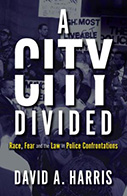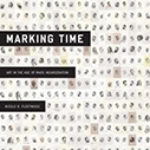A City Divided: Race, Fear, And The Law In Police Confrontations

Author: David A. Harris
Publisher: London; New York: Anthem Press, 2020. 354p.
Reviewer: Brandon T. Jett | August 2021
A City Divided: Race, Fear, and the Law in Police Confrontations explores incidents of police violence against African Americans in the United States. To delve into this delicate issue, David A. Harris takes a really interesting approach by combining both micro- and macro-level analysis. Harris examines the case of Jordan Miles, an unarmed black teenager who was assaulted by three Pittsburgh police officers as they attempted to arrest him on January 12, 2010. Anyone who has watched videos of police shootings over the last several years will be familiar with the ensuing trajectory, as it mirrors the story of any number of cases of police abuse/killing of unarmed black men. The Miles case differs, however, in that he did not die. Thus, we have an understanding of Miles’s interpretation of the events that differed markedly from the police officers’ accounts. There were also criminal and civil cases against Miles and the police officers involved in his arrest. At the macro level, Harris explores larger social-psychological issues of race, fear, implicit bias, and other issues that shape both police officers’ and black men and women’s thinking and behaviors during encounters. He concludes that multiple factors contribute to the way violent encounters between police and black men and women unfold that must be addressed in order to reduce the instances of police abuse.
This book is divided into four parts. The first section explores the violent arrest of the aforementioned Jordan Miles on January 12, 2010, the immediate aftermath, and the various criminal investigations. We get a sense of who Miles was and how he lived, who the police officers were and how their backgrounds shaped their understanding of the incident, and how this violent encounter unfolded. Harris also takes the reader through the complicated criminal proceedings that occurred after the incident, including charges that were ultimately dismissed against Miles, and the federal and county investigations into the officers’ actions that also ultimately amounted to nothing. Harris does a fine job of explaining these complicated legal matters and processes in a way that will be digestible by the general public.
The second part of the book gets into the macro-level factors that contributed to the incident and others like it. The author explores the role of race and implicit bias, the role of fear in police encounters that shape how African Americans respond to law enforcement officers, and how fear also shapes police understandings of their job and their encounters with Black Americans. Harris is really at his best when critiquing the “warrior mentality” that frames every police interaction as potentially life threatening. He writes: “police officers now think of themselves as fighting a war, as warriors: not in the sense of participating in a generalized ‘war on crime’ or ‘war on drugs’ crusade or program but as people who dedicate themselves as soldiers, willing to use violence as necessary in the fight to protect the rest of us against an evil enemy” (119). This mentality leads them to view and treat all civilians, but especially African Americans, as potential enemies. If, according to Harris, police officers treat all encounters with the public, the majority of which do not end in violence or threats to officers’ lives, as potentially life threatening, then the likelihood that police will treat civilians aggressively or be overly hostile in their interactions increases exponentially.
The book’s third section explores the civil trials that unfolded when the criminal prosecutions came to naught. Over the course of two civil trials, Harris delves into the structural impediments that limit accountability for police officers. Because the criminal investigations never resulted in prosecutions of the officers involved, the last resort for Jordan Miles was the civil arena. Even here, Harris points out, the process came up short. At the end of the first civil case, the jury found the officers not guilty of violating Miles’s Fourth Amendment rights by subjecting him to malicious prosecution, but did not reach a verdict on the other two counts — unlawful seizure and use of excessive force. A second trial was required to determine the outcome of those final two charges. At the end of the second trial, the jury decided that the officers did not have grounds to arrest Miles, but that they did not use excessive force when they attempted to arrest him. As Harris poignantly asks, “[i]f the officers falsely arrested Jordan, how could the law justify any amount of force?” (p. 223) The jury awarded Miles $119,016.75. Miles’s lawyers appealed that ruling, and in the intervening ten months the city and Miles reached a settlement agreement. Finally, after six years and a complete disruption of Miles’s life, his attorney reached a settlement with the city as the second civil trial was underway. He was awarded $125,000.
Although the complicated legal trajectory of the various investigations, trials, and appeals is a bit cumbersome, the author offers some excellent insights into the systemic problems in the American judicial system. Harris’s examination of the civil litigation process involving police abuse claims is perhaps the strongest part of the book. He explains the effects of the Marek v. Chesney decision in 1985, which determined that Rule 68 of the Federal Rules of Civil Procedure applied to civil rights cases. This rule applies specifically in cases where the defendant offers a settlement that is rejected by the plaintiff. As Harris explains, “[i]f the judgement the plaintiff is actually awarded at the end of the trial is less than what the defendant had offered earlier on, the plaintiff has to pay all of the costs the defendant accrued in fighting the case after the defendant made the offer, and the plaintiff cannot recover any costs incurred by the plaintiff after the offer” (p. 85). This decision, as well as many other rules and rulings that Harris explains, essentially shield police officers and police departments from facing any accountability for their abusive actions, while all the while shortchanging victims from gaining compensation.
In the final section, Harris lays out a ten-point plan to ease the tensions between police and Black communities. Many of these suggestions will sound familiar to some readers, but the important part is that the suggestions are largely accomplishable. His suggestions include: moving police from a warrior to a guardian police outlook; training that separates fear from threat; returning to community policing; racial reconciliation as a necessary precursor to any reform effort; recalibrating the law on the use of force by police; action on guns; training on implicit bias and procedural justice; reducing urban violence; and, increased transparency and accountability from police departments, especially in cases involving police violence. Harris provides nuanced explanations for each of his proposals.
A City Divided is an important look into one of the main issues facing criminal justice today. The author does an excellent job of walking the tightrope between blanket criticism of police as being uncompromisingly racist, but instead, takes a dispassionate approach to explore the issues that shape how police officers do their job, how they are trained, and how things like the “warrior mentality” create problems. Moreover, he amply demonstrates the factors that contribute to black suspicions of police motivations during these often-deadly encounters. If we are to take Harris at his word, then the problems surrounding policing and Black communities today can be changed without complete abolition of the police, as many activists are recommending. Instead, the police as an institution can be reformed in ways that will make departments and officers more responsive and amenable to the needs of the communities they serve. This book is a must read for anyone interested in a better understanding of the complicated issues related to race, crime, and policing today.
Brandon T. Jett, Professor of History, Florida SouthWestern State College


